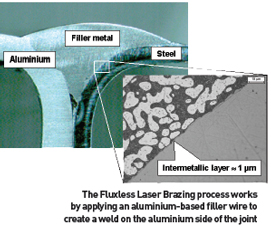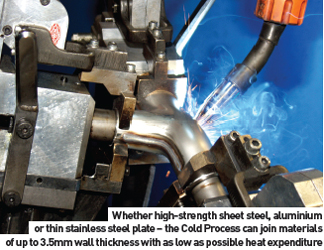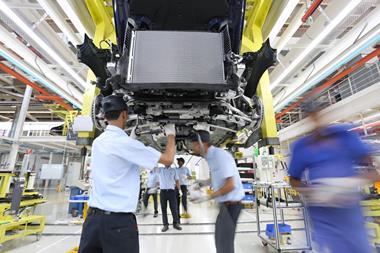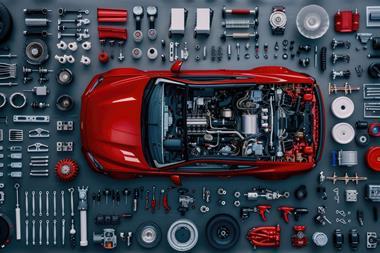As the automotive industry introduces new combinations of metals, making sure they retain overall strength and avoid corrosion when welded has led to a range of innovative joining technologies.
Welding has evolved within the automotive industry in recent years to embrace automation and robotics like no other process.One particular stimulant for this change is brought about by the combination of different materials now used to join the various parts of a car body together.
Steelmaker Corus has developed Fluxless Laser Brazing, a new and robust process for joining steel to aluminium during automotive production line assembly developed in Holland. Although reducing weight to improve CO2 emissions remains one of the main drivers in the global automotive industry, the need to reduce weight is balanced against the need to keep manufacturing costs down.
Thanks to its performance and cost benefits, there is little doubt that steel will remain the material of choice for main vehicle body structures in volume car production. However, Corus says that designers are substituting aluminium for steel for specific applications, such as the bonnet and roof, where advantages beyond weight reduction, such as weight distribution for optimum ride and handling, can be achieved.
Until now, the welding of steel to aluminium has been a complicated process and one that poses specific problems to vehicle makers. For example, when the two different materials are welded together, it results in a thick intermetallic layer, which can result in a brittle and weak weld joint,.Controlling the heat input using laser-based welding techniques is one way of reducing the thickness of this inter-metallic layer. However, traditional laser welding methods require the use of a salt-based flux to enable a joint to be created. This is not without problems as a saltbased flux is more prone to expose the joint to corrosion.
The new Fluxless Laser Brazing process removes the need to apply a flux during the welding process that, Corus thinks, will help take significant costs and time out of the manufacturing process. Removing the saltbased flux also removes the potential source of weld corrosion.
The Fluxless Laser Brazing process works by applying an aluminium-based filler wire to create a weld on the aluminium side of the joint. The molten filler metal then ‘wets’ the steel creating a brazed joint on the steel side of the weld. Importantly, tests indicate that this new technique creates only a very thin inter-metallic layer making it possible to create joints that are, in some cases, stronger than the base materials themselves.
Jurgen Vrenken of Corus RD&T said: “We believe our new welding process is ideally suited to joining aluminium components, for example a roof, into a steel body-in-white, offering vehicle makers further options for saving weight beyond the use of advanced high-strength steels.”
Cloos and Presswerk Struthütten (PWS) have been working on a new Cold Process welding method for high temperature exhaust parts. “We specialise in the hot side of exhaust systems,” Michael Jud, Technical Managing Director of PWS explains. “Here the parts for the manifolds must withstand hot exhaust gases of up to 900 degrees over many years without any problems occurring.”
These requirements can only be fulfilled by using high quality materials, optimum designs and the appropriate production technology; PWS only uses stainless steel plate for these hot products.
“To be able to respond to the cost pressures from the vehicle makers, we first modified the parts to enable them to be produced as punched parts and not by using the costly hydroform technology,” Jud explains. However, the welding technology requirements increased considerably so that PWS could not achieve the required quality and production throughput with the conventional processes.
According to Jud these three dimensional punched parts with plate thicknesses of around 1mm naturally show very different gap dimensions. “Also, vehicle makers demand spatter-free components because under the extremely hot conditions spatter can be released in the exhaust and destroy the catalysers for example.”
As the processes of different manufacturers did not produce the required results, PWS decided on the new Cold Process from the Cloos welding specialists in Haiger.
While current pulsed arc-welding processes are unipolar/ positively poled, the Cloos Cold Process uses changing polarities. Thus the relative heat input in the wire electrode or workpiece becomes controllable. This results in a considerably reduced heat input in the weld and in the welded material itself. This again reduces component distortion and the problem of crack formation, which, with exhaust system components on cars, would lead to many complaints. “Since CP welds are nearly spatter-free, rework on the components is considerably reduced,” Braun explains.
Whether high-strength sheet steel, aluminium or thin stainless steel plate – the Cold Process can join materials of up to 3.5mm wall thickness with as low as possible heat expenditure. In the pulse phase there is maximum spatter free deposition from the wire. During the negative phase the arc surrounds the wire end, directing the heat into the wire and cooling the weld pool. Due to the lower heat input with the cold welding process penetration is minimised, resulting in a significant reduction in surface discolouration. Even in the case of coated plate the surface remains in good condition.
Tim Oppermann, in charge of welding technology at PWS, says another benefit is the improved gap-bridging ability, which enables punched parts to be welded. A tour of the production department shows what he is talking about: the two punched T half shells of stainless steel plate have differing gap dimensions from zero to more than 2mm when assembled. “However, with CP there’s no problem,” he adds.
The Cold Process makes considerably higher welding speeds possible, resulting in shorter cycle times. This new process achieves welding speeds of an astonishing 2.2 metres per minute – even with the complex PWS components that have welds with numerous bends and narrow radii.
The experts would not give exact details but under certain circumstances it is possible to achieve twice the speed.
The Z2 compact production cell used for Cold Process welding uses two stationary work tables. While the operator unloads one finished component from the first work table and loads two new half shells, the Romat robot is already welding again at the second work place.
On an area of only 3.90 x 2.25 metres the Z2 contains all the necessary components, such as a robot with water cooled welding equipment, Duo Drive wire-drive unit and a torch clean unit. The controller and the Quinto CP pulsed arc power source are also mounted on the base frame. On the front side, the two work tables are located behind two sliding doors which are opened alternately. “When welding is complete, the door opens automatically and the operator can remove the finished component,” Jud says.
The complete cell can be easily moved via forklift if any changes to the production run are required, as the appropriate facilities for transportation are located underneath the base frame. The cell only needs to be connected to the electric supply, compressed air and shielding gas to be ready to work.
At Opel’s plant in Bochum, Cold Metal Transfer (CMT) has proved itself in both welding and brazing. Undesirable effects such as the accumulation of spatter, corrosion susceptibility of the seam area and distortion are reduced to a minimum.
In the steel construction department at Opel Plant 1 the bodywork passes through robot cells using CMT brazing and welding applications. The CMT welding process replaces the abilities of experienced manual welding experts and synchronises the joining of 6mm thick door hinge flanges to 0.8mm thin bodywork sheets with the production flow. The task is even more difficult, as the rear panel surfaces to be joined on the A and B pillars and the hinge flange do not run parallel, instead they form a wedge-shaped gap of between zero and 3mm.
Opel finds process-capable solutions
“About 50 robots do the brazing or welding work per arc.
This will increase relative to the robots used for resistance spot welding,” predicts Hans-Jürgen Pawlik, Head of Planning and Production. Sixteen robots do the welding and brazing work using CMT systems from Fronius.
CMT technology was first used for brazing at Bochum. On the bodywork floor, joins with a relatively large gap are brazed. This eliminates the sheet distortion and damage to galvanised layer and spatter problems typical of the high heat required in MSG (metal shielding gas) welding. Since the beginning of 2005, eight robots have been carrying out perfect brazing work on joins with the TransPuls Synergic 4000 CMT system.
Pawlik sums up: “The reduction of the cycle time means we can rectify the bottleneck that used to occur at the welding station. Spatter-free welding means torches malfunction less often. And the gap bridging with CMT is greater than was achievable with MIG/MAG brazing.”
He and others attribute the advantages of the original CMT technology over conventional MIG/MAG processes to the specific characteristics of this innovative technology: a reversal of the wire movement with a frequency of up to 90 Hz supports droplet detachment, minimises heat input, reduces material distortion, increases gap bridging, decreases spatter and proves the metallurgic intrinsic connection between the parts being joined.
The American Bureau of Labour estimated, that in America, there are more than 365,000 accidents during welding processes every year.
The ears
The skin of the ears is very thin and needs to be protected against UV- and IR-radiation to avoid a skin burn and ultimately, skin cancer. Also, for some welding processes, the welder should wear ear protection products. For example, TIG-welding can cause approximately to 121dbi which doesn’t take long to cause irritation and damage.
The eyes
The intensity of the welding arc needs to be decreased to protect the eyes and, using a welding helmet, this function is taken care of by liquid crystals or darkened protection glasses. The necessary view of the welding object persists, while the intensity gets decreased. A much higher danger, however, comes from the UVand IR-radiations. To protect properly against this, a filter is needed which securely and permanently reflects the dangerous radiation.
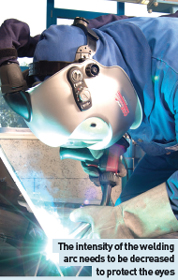 The skin
The skin
Seventy per cent of the accidents recorded by the American Bureau of Labour are burns and injuries caused by fl ying particles. Additionally, UV and IR-radiation cause burns. This radiation can lead not only to heavy burns, but also skin cancer. Just a few minutes is enough to lead to skin irritations, especially in the neck and chest area. The face and the neck must be covered totally to avoid any burns.
The lung and respiratory tracts
Depending on the welding process and the material used, particles, dust or toxic fumes and gases can be released. These lead to headaches, or coughing. If not corrected, they can destroy the lungs and respiratory tracts and result in a serious and dangerous illness.
An analysis of the materials used and the working environment can help to find the right protection. PAPR-systems with gas or/and particle filter or supplied air systems can be used to minimise the risks greatly.
The feet and hands
During welding, spatters and hot particles could burns, especially of exposed body parts. Also, the welder is – in many situations – not protected against falling materials. Suitable gloves and shoes are needed to protect efficiently.






























